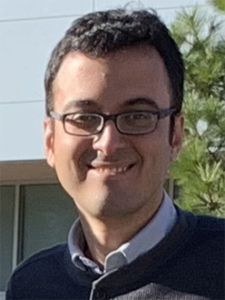 The Department of Mechanical Engineering is excited to welcome Dr. Amir Arzani as an assistant professor this fall. Dr. Arzani received his BS from Isfahan University of Technology, his MS from Illinois Institute of Technology and a Ph.D. from UC Berkely, all in mechanical engineering. He was previously an assistant professor at Northern Arizona University. In addition to being a member of the mechanical engineering department, he is also part of the Scientific Computing and Imaging (SCI) Institute.
The Department of Mechanical Engineering is excited to welcome Dr. Amir Arzani as an assistant professor this fall. Dr. Arzani received his BS from Isfahan University of Technology, his MS from Illinois Institute of Technology and a Ph.D. from UC Berkely, all in mechanical engineering. He was previously an assistant professor at Northern Arizona University. In addition to being a member of the mechanical engineering department, he is also part of the Scientific Computing and Imaging (SCI) Institute.
Arzani’s research involves developing computational models that can help us understand the fundamental blood flow processes involved in cardiovascular disease. His lab is interested in fundamental understanding and high-fidelity quantification of complex unsteady fluid flow problems. Their work also involves developing computational solid mechanics and fluid-structure interaction models that help predict cardiovascular disease growth. They are also interested in developing data-driven and scientific machine learning models that can help us achieve the above goals.
“I am very excited about all the collaboration opportunities and internationally recognized expertise we have here at the U,” said Arzani. “In the Mechanical Engineering Department, the environmental flow modeling group does very exciting fundamental fluid mechanics research that matches my interests. Additionally, related to my interests, there are very impressive research projects in biomechanics, computational mechanics, and thermal sciences that I hope to learn more about. Similarly in SCI, there are experts in visualization, image processing, and scientific computing, which are all areas that I have worked on, and it is amazing to be among world-class experts in these topics.”
Arzani’s lab is currently funded by 4 NSF projects where they are developing multiscale biomechanics models of cardiovascular disease growth, using medical image processing together with scientific machine learning to quantify blood flow, improving the quality of experimental blood flow models using data-driven modeling, and developing physics-informed neural network models that can be used for hybrid physics-based and data-driven modeling of unsteady fluid flows such as cardiovascular flows. They are also exploring new projects with the faculty in Utah and their collaborators throughout the country.
“I am very happy and proud to be part of the U family and the Mechanical Engineering Department,” said Arzani. “I look forward to working with the amazing students, staff, and faculty here in Utah and contributing to our growing success and recognition as a top public school. My family and I are also very excited about Salt Lake City and all of the indoor (concerts, sports, museums,..) and outdoor activities that it offers. Go Utes!”
You can visit the Computational Biomechanics Group website to learn more.